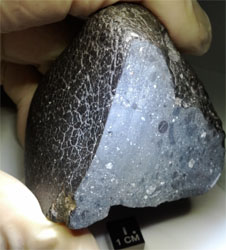Black Beauty Carrying Water Found on Sahara Desert
NASA-funded researchers analyzing a small meteorite that may be the first discovered from the Martian surface or crust have found it contains 10 times more water than other Martian meteorites from unknown origins.
This new class of meteorite was found in 2011 in the Sahara Desert. Designated Northwest Africa (NWA) 7034, and nicknamed “Black Beauty,” it weighs approximately 11 ounces (320 grams).
After more than a year of intensive study, a team of U.S. scientists determined the meteorite formed 2.1 billion years ago during the beginning of the most recent geologic period on Mars, known as the Amazonian.
[ Also Read: Exploring Curiosity with Social Media Platform Foursquare ]“The age of NWA 7034 is important because it is significantly older than most other Martian meteorites,” said Mitch Schulte, program scientist for the Mars Exploration Program at NASA Headquarters in Washington. “We now have insight into a piece of Mars’ history at a critical time in its evolution.”
The meteorite is stated to be an excellent match for surface rocks and outcrops NASA has studied remotely via Mars rovers and Mars-orbiting satellites. NWA 7034’s composition is different from any previously studied Martian meteorite.
[ Also Read: NASA Selects Small Businesses for Tech Projects ]“The contents of this meteorite may challenge many long held notions about Martian geology,” said John Grunsfeld, associate administrator for NASA’s Science Mission Directorate in Washington. “These findings also present an important reference frame for the Curiosity rover as it searches for reduced organics in the minerals exposed in the bedrock of Gale Crater.”
NWA 7034 is made of cemented fragments of basalt, rock that forms from rapidly cooled lava. The fragments are primarily feldspar and pyroxene, most likely from volcanic activity. This unusual meteorite’s chemistry matches that of the Martian crust as measured by NASA’s Mars Exploration Rovers and Mars Odyssey Orbiter.
The research team included groups at the University of California at San Diego and the Carnegie Institution in Washington. Experiments were conducted to analyze mineral and chemical composition, age, and water content.
The research was funded by NASA’s Cosmochemistry Program and Astrobiology Institute, part of the Planetary Science Division in the Science Mission Directorate at NASA Headquarters.
The research also was supported by the New Mexico Space Grant Consortium in Las Cruces, and the National Science Foundation in Arlington, Va.
Photo courtesy: NASA


